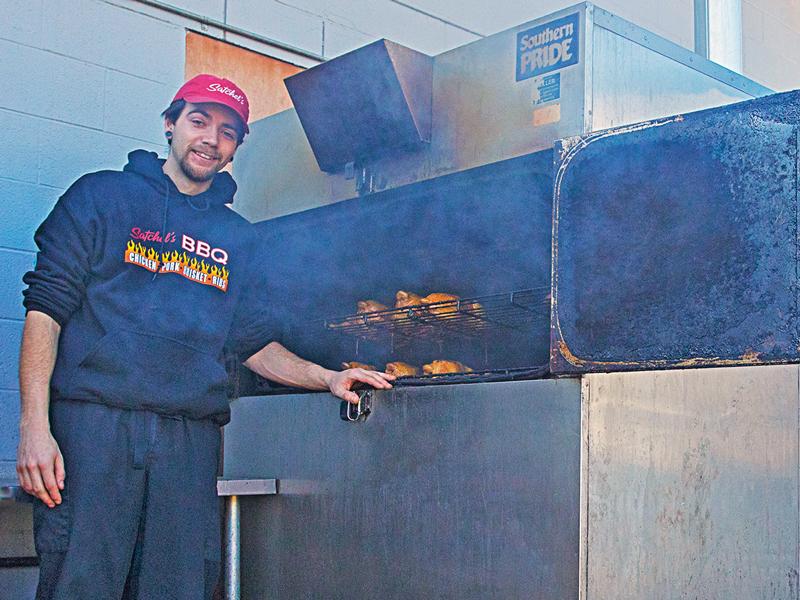Barbecue! Those smokers outside restaurants smell so good that they make our mouths water. Since our mission is to explore the outside, we figured that was excuse enough to investigate. We narrowed our search to two restaurants that share emblematic smokers but embrace fundamentally different philosophies: Satchel’s BBQ relies on high-tech equipment, while Zingerman’s Roadhouse smokes its artisanal meats in a traditional low-tech cinder block pit.
Tucked behind a Verizon store on Washtenaw, Satchel’s attracts passing motorists with a pair of barrel pits parked near the street. Manager D.G. Garner says they’re used seasonally for chicken and kielbasa. But most of the cooking, we learned, takes place in two identical Southern Pride stainless steel rectangular units at the rear of the restaurant. Each commercially manufactured unit has a side-mounted firebox, a propane injector, and a ten-shelf rotisserie grill that is constantly turning. There are also two fans, one to direct the smoke into the grill chamber from the firebox and a second to evenly circulate the air in the grill chamber itself.
Temperature and time are controlled automatically by firing the propane injector as needed. Garner enthusiastically extols its two major features: “First is the rotisserie which cooks evenly; the second is the ability to automatically hold a temperature.” That makes them pretty much set-it-and-forget-it devices that need only regular additions of wood. Garner favors a mix of two-thirds hickory and one-third fruitwood such as cherry or apple.
Contrast this with the Zingerman’s Roadhouse pit, which sits alongside the enclosed patio at the Westgate restaurant. Designed by chef Alex Young and custom built in 2003, it consists of three cinder block units with metal fireboxes directly below and barrel-roll-shaped metal covers. The multiple units allow the use of different meats or recipes at the same time.
Young described the pit with pride as being “super old school.” Controlling it challenges the pit master’s skill. “It is a craft,” he explains. “You have to understand fire, airflow, air temperature, size of the meat you are cooking.”
Temperature is regulated manually with a series of vents. No built-in fans, timers or digital thermometers—pit master Javier Aquino, a man who radiates enthusiasm for his work, checks the heat by placing his hand on the barrel. He aims for about 200 degrees, depending on what he’s cooking. The woods currently used are oak and cherry, sometimes with the addition of charcoal depending on the recipe.
We have also sampled smoky wares from outdoor smokers at Westside BBQ on Madison, Ron’s Barbeque at Romanoff’s on Pontiac Tr., and, seasonally, the Ricewood food truck behind Morgan & York on Packard. The next time you stop for barbecue, take a peek at how it’s produced.
—
This article has been edited since it was published in the April 2017 Ann Arbor Observer. The spelling of D.G. Garner’s last name has been corrected.
